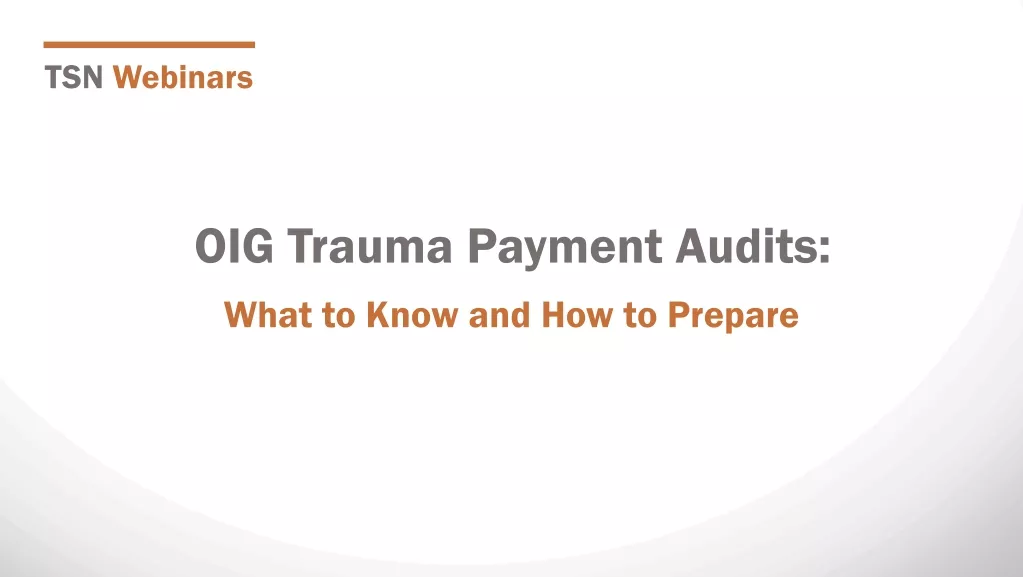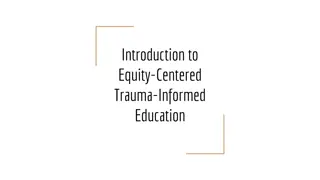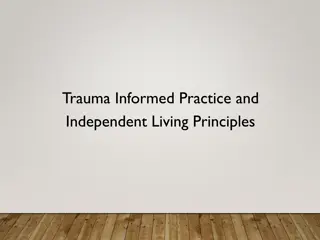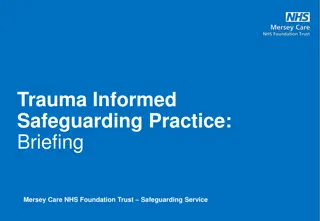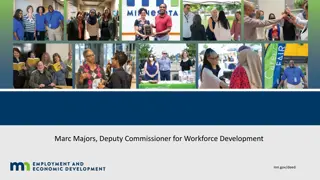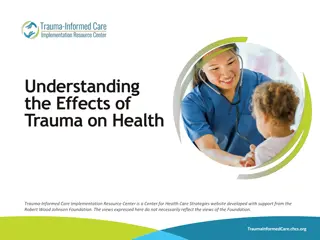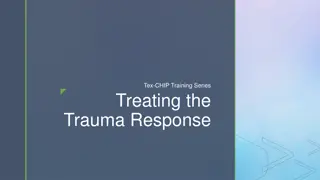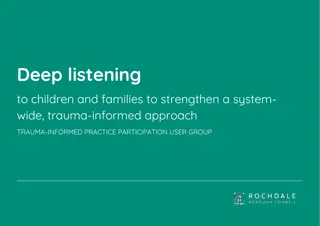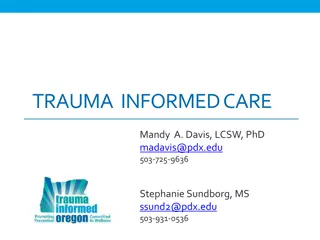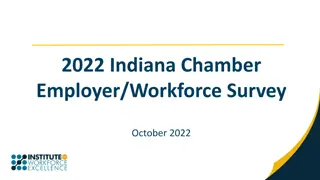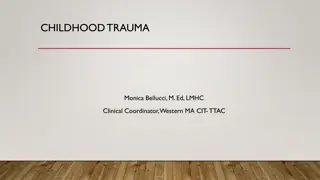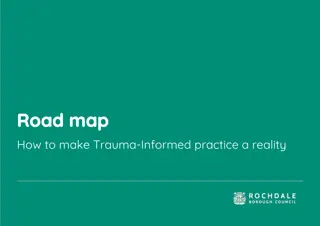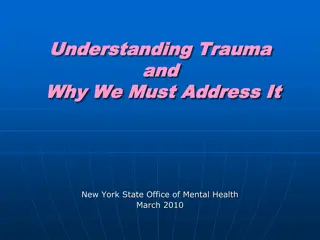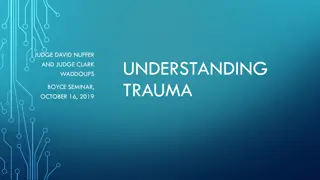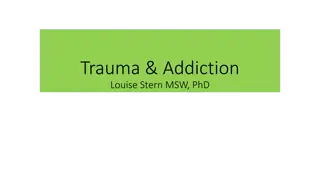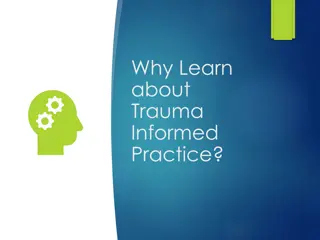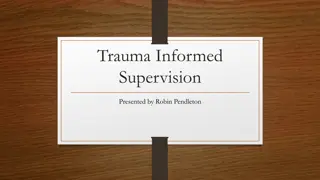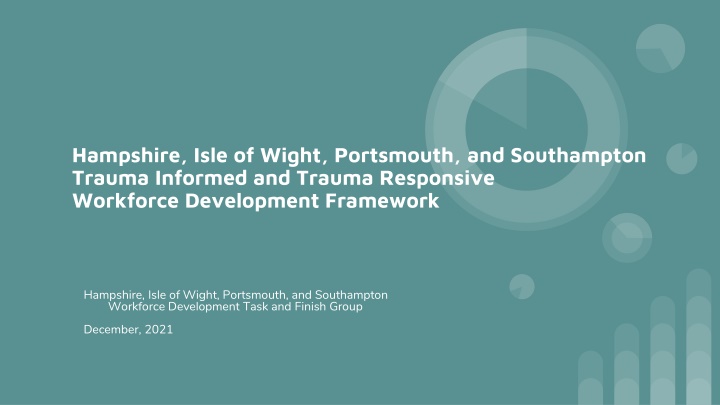
Trauma-Informed Workforce Development Framework - Hampshire, Isle of Wight, Portsmouth, Southampton
Explore the Trauma-Informed Workforce Development Framework in Hampshire, Isle of Wight, Portsmouth, and Southampton. Understand the impact of trauma, staff responses, and organizational adaptations for better outcomes. Discover the relevance of this framework for the entire workforce in various sectors to address hidden traumas and improve overall well-being.
Download Presentation

Please find below an Image/Link to download the presentation.
The content on the website is provided AS IS for your information and personal use only. It may not be sold, licensed, or shared on other websites without obtaining consent from the author. If you encounter any issues during the download, it is possible that the publisher has removed the file from their server.
You are allowed to download the files provided on this website for personal or commercial use, subject to the condition that they are used lawfully. All files are the property of their respective owners.
The content on the website is provided AS IS for your information and personal use only. It may not be sold, licensed, or shared on other websites without obtaining consent from the author.
E N D
Presentation Transcript
Hampshire, Isle of Wight, Portsmouth, and Southampton Trauma Informed and Trauma Responsive Workforce Development Framework Hampshire, Isle of Wight, Portsmouth, and Southampton Workforce Development Task and Finish Group December, 2021
Introduction There is emerging evidence that trauma-informed practice, where the impact of trauma on those affected by it is understood and staff responses and organisational systems can be adapted accordingly, leads to better outcomes. Workforce development is one of the 10 domains* for the implementation of a Trauma Informed Approach (TIA) across any organisation or system. This framework is designed to be relevant to public services workforce across Hampshire. Living through traumatic events: is a common experience across society and across the lifespan has a broad range of possible impacts on health, mental health as well as social outcomes such as education and justice. Underpinning this document is an acknowledgement that safe, effective, empowering relationships are key to enhancing resilience and recovery for those affected by trauma. This framework is designed to reflect the range of roles that workers may have in relation to providing services to people who have lived through traumatic experiences. These are not hierarchical and will not necessarily reflect someone s seniority within their organisation or profession but the nature of the role they hold in relation to their responsibilities to and work with those affected by trauma. This framework includes a variety of levels of practice that workforces can achieve: informed, skilled, enhanced, and specialist. Template examples are provided to assist training needs assessment, undertake a practice audit based on the 5 SAMHSA* Principles: Safety, Trustworthiness, Choice, Collaboration, and Empowerment. Lastly, areas to consider in identifying quality training are covered. *Substance misuse and mental health services administration (SAMHSA), 2014, Concept of Trauma and Guidance for a TIA, https://store.samhsa.gov/sites/default/files/d7/priv/sma14-4884.pdf The other 9 domains are: governance and leadership; policy, physical environment; engagement and involvement; cross sector collaboration; (screening), assessment, treatment services; progress monitoring and quality assurance; financing and evaluation.
Why is this Framework relevant to the entire Workforce? We now understand that whilst living through trauma is relatively common, the experience and its impact is often hidden. What has become increasingly recognised over the last 20 years is the long term impact that the experience of trauma can have on a wide range of health and social outcomes, as well as upon mental health. In addition to the impact on mental health and wellbeing, living through traumatic events increases the risk of a range of physical health conditions (for example type II diabetes and cardiovascular disease), increases the chance of engaging in the criminal justice system, and is associated with poorer educational attainment. Despite the association between the experience of trauma and poorer physical, social and educational outcomes, we also now understand that people affected by trauma can be less likely than others to seek or receive the help or support they need, for a range of reasons. In its application to the entire workforce, the framework reflects the important roles of staff working in a broad range of settings (for example physical health, criminal justice, education, social care) to realise the high prevalence and broad impact of trauma, to recognise the impact of trauma in the people they serve, and to adapt practice accordingly in order to achieve positive outcomes.
Understanding the Rationale for Workforce- wide Trauma Informed Practice A workforce that is able to recognise where an individual may be affected by trauma and adapt practice accordingly in order to minimise distress and maximise trust can do two things. First, it supports the recovery of those affected by trauma empowering them and providing them with a different experience of relationships, one in which they are offered safety rather than threat, choice rather than control, collaboration rather than coercion and trust rather than betrayal. Each encounter provides an opportunity to reverse the association between trauma and relationships, and is an important part of recovery. Second, it minimises the barriers to receiving care, support and interventions that those affected by trauma can experience when memories of trauma are triggered by aspects of the service or interactions with staff. People affected by trauma can become highly sensitive to subtle (as well as obvious) reminders of their previous traumatic experiences and relationships. Such reminders, and the distress that they cause, is another reason why people affected by trauma do not engage with or drop out from the care, support and interventions that they need. Trauma informed care allows workers and services to explicitly identify and adapt any aspects of their service that may trigger distress associated with trauma, in order to minimise it.
How to use this Framework This framework can be used by: Practitioners/Workers: (in conjunction with their appropriate generic and/or professional guidance, where available) to help them understand the knowledge and skills expected of them to successfully deliver trauma informed, evidence-based and effective services. Managers and Supervisors: To lead by example and champion a trauma informed approach, and to identify and explore staff strengths and address any gaps in staff knowledge and skill. Organisation: To become a culturally trauma informed organisation and to ensure staff have the necessary knowledge and skills to meet the needs of people affected by trauma, their families, carers and supporters; this should be done through planning staff development activities to meet the aspirations of the framework, which also includes ensuring staff welfare. Education and Training Providers: To inform the content of their curriculum and learning activities.
Outcomes of Trauma Informed Practice TI practice components Short-term outcomes Long-term outcomes Training of all staff Staff knowledge, attitudes, skills Ongoing support for all staff Staff satisfaction, turnover, health, vicarious trauma. TI Practice Delivery Change in staff behaviour. Quality of staff-user interactions. Complaints. Organisational readiness and capacity. Availability and quality of services. Barriers to access services. Trauma screening and assessment. Referrals to trauma specific services. Physical environment Staff and service user perceptions of physical and psychological safety. Service user engagement and satisfaction Service user satisfaction with the service (User voice) Service User outcomes Quality of life, mental and physical health, safety. Policies and protocols on TI practice Written policies and protocols Collaboration across sectors Shared understanding of TI approach among staff Enablers Buy-in from governance and leadership. Onsite or external trauma-specific services. Financing Costs of TI practice, value for money
Practice Level Definitions The following slides detail the level of practice that workforces should aim for when considering their trauma training plan. There also some examples of job roles that may apply to each level, the examples are not an exhaustive list, and are provided as a point of reference to support organisations moving forward. To support the journey of being trauma informed, it is recommended that all staff attend the trauma informed session before extending their knowledge into the relevant level for their role.
Levels of Skills and Knowledge Each level describes the expected knowledge, skills and behaviours specific to a worker's role in relation to trauma-informed or trauma specific practice. Rather than being hierarchical, the levels reflect the level of responsibility the worker has to respond to the impact of trauma. This will vary greatly across organisations and sectors and also by job role. Each level defines the responsibility a worker carries, but this does not necessarily simply correspond to the worker s seniority within the organisation or professionally. Trauma Informed Practice level describes the baseline knowledge and skills which would be beneficial to everyone in the workforce. Trauma Skilled Practice level describes the knowledge and skills required by all workers who have direct and/or substantial contact with individuals (children and adults) who may be affected by traumatic events, whether or not trauma is known about. This level is likely to be relevant to staff from statutory services such as health and social care, justice staff, emergency services and third sector organisations.
Levels of Skills and Knowledge Trauma Enhanced Practice level details the knowledge and skills required by workers who have more regular and intense contact with individuals (children and adults) who are known to be affected by traumatic events, and who provide specific supports or interventions and/or who direct or manage services. Trauma Specialist Practice level details the knowledge and skills required by staff who, by virtue of their role and practice setting, play a specialist role in directly providing evidence-based psychological interventions or therapies to individuals affected by traumatic events and/or in offering consultation to inform the care and treatment of those affected by trauma and/or in managing trauma-specific services and/or in leading in the development of trauma-specific services and /or in co-ordinating multi-agency service-level responses to trauma. This level is likely to be relevant to the range of services and organisations that deliver services to children and adults affected by trauma, and include third sector, mental health and substance misuse services, and prison and homelessness services.
Trauma Skilled Trauma Informed Trauma Enhanced Trauma Specialist Workers who have a specific remit to respond to people known to be affected by trauma and are required to provide advocacy support or interventions or are required to adapt the way they work to take into account trauma reactions to do their job well and reduce risk of re- traumatisation or are required to manage these services. Workers who are likely to be coming into contact with people who may have been affected by trauma All Workers - All workers would benefit from an awareness at this level. Workers who have a specific remit to provide specialist support interventions or therapies for people known to be affected by trauma with complex needs. Mental Health Nurses and Workers, Specialist Domestic Abuse Support and Advocacy Workers, Educational Support Teachers, Some Specialist Police Officers, some Psychiatrists, Forensic Medical Examiners, Social Workers, Prison Staff, Secure Unit Workers, Drug and Alcohol Workers and Specialist Counsellors. Social Workers with Specialist Roles/Training, Major Incident Workers, Some Psychiatrists, Managers of Highly Specialist Services, Psychologists and Other Therapists. GPs, Teachers, SENDCOs, and Pastoral/Send Staff, Police Officers, Early Years Staff, Sports Coaches, Receptionists, Dentists, A&E Workers, Lecturers, Housing Workers, Care Workers, Service Managers, Youth Workers, 0-19 Public Health Nurses and Counsellors. Shop Workers, Taxi Drivers, Recreation Workers, Police Staff, All School staff. NB: Examples provided are not a definitive list and are provided as a guide.
Levels of Skills and Knowledge What workers Know ( Knowledge) What workers are able to do (capability/skill/ability) 1 Respond to the person by asking what help (if any) he or she needs. Hold in mind that a person s behaviour or reactions might be trauma-related. Make sense of a person's current difficulties by considering (but not asking) What happened to you? , instead of What s wrong with you? , in responding to a person affected by trauma. That trauma can affect people s mental health, physical health, capacity for learning and life chances. That the consequences of trauma can affect people's ability to successfully access the care, support and treatment they require in a range of settings (for example physical health, mental health, education, justice, employment, housing). That a person s young age when first experiencing trauma, the person(s) responsible for the trauma and its duration are among the reasons for people s different responses to trauma Trauma Informed That people exposed to trauma can become primed to see danger and can react with a fight-or-flight response to situations that trigger the harm they experienced before: in these situations, the person can sometimes feel as bad as when the trauma was actually happening (this is called re-traumatisation). That situations in which feelings of trust, choice, collaboration, empowerment and safety are compromised can lead to trauma related distress or re-traumatisation, and can lead people to drop out from or avoid care, support or treatment. Appreciate that a person might feel distressed or even re-traumatised in certain situations if they are triggered by a past trauma. Identify areas of own practice and processes that may be experienced by those affected by trauma as " through lack of control, choice, collaboration, empowerment trust and safety.
Level 2: Trauma Skilled Knowledge and skills required for workers with direct and frequent contact with people who may be affected by trauma.
Levels of Skills and Knowledge What workers Know ( Knowledge) What workers are able to do (capability/skill/ability) 2 That there are a range of responses to traumatic events, from no effect/resilience through to a significant life-changing impact across a range of areas of health and well-being. That people affected by past complex trauma commonly have difficulty managing feelings and find it difficult to trust others. All workers can: Relate to people they come into contact with using trauma-informed principles regardless of whether a history of trauma is known or identified. Managers can: Translate an understanding of the prevalence of trauma into trauma-informed service systems and procedures and ensure effective support for staff. Trauma Skilled Child and family workers understand: That, without access to a good enough attachment figure (particularly eary years), trauma can interfere with a child s ability to learn and develop relationships with peers. That trauma in childhood includes neglect as well as physical, sexual and emotional abuse, as neglect means that the child s needs are not being met. Child and family workers can: Recognise indicators of trauma and its impact, and use child protection procedures where required.
Level 3: Trauma Enhanced Knowledge and skills for staff with regular and intense contact with people affected by trauma and who have a specific remit to respond by providing support, advocacy or specific psychological interventions to protocol, and/or staff with responsibility for directly managing care and/or services for those affected by trauma.
Levels of Skills and Knowledge What workers Know ( Knowledge) What workers are able to do (capability/skill/ability) 3 All workers can: Recognise where the experience of trauma is having an effect on a person's relationship with a worker or service, and adapt accordingly. Help people recognise links between current difficulties or needs and past experiences of trauma. The importance of giving the message its what happened to you, not what s wrong with you in enabling individuals to feel safe within themselves and build a positive sense of self. Trauma Enhanced That the risk of experiencing further trauma / re victimization can be linked to a combination of external risk factors (such as debt, poverty or gang involvement), internal risk factors (including poor sense of self-worth) and relational risk factors (e.g. a coercive and controlling partner). That difficulties which may raise safety concerns, such as self-harm and substance misuse, may have developed as a means of coping with the impact of trauma. Recognise when trauma reactions are compromising the safety of the individual and/or the safety of others, and respond accordingly to mitigate any risks and, in collaboration with the individual develop safety.
Level 4: Trauma Specialist Knowledge and skills for staff who have a remit to provide evidence-based interventions and treatment for those affected by trauma with complex needs.
Levels of Skills and Knowledge What workers Know ( Knowledge) What workers are able to do (capability/skill/ability) 4 That coping strategies (self-harm, substance misuse) and certain trauma reactions (eg dissociation, numbing) are a person s attempt to stay within their window of tolerance" in the absence of alternative available self-soothing skills. That trauma-related distress can be inadvertently triggered in every-day life due to contact with internal or external stimuli which reminds the person of past trauma. That emotion coping/affect regulation skills development is an important part of trauma-focussed therapy. All workers can: Evaluate the need for, and appropriate focus of therapy. Provide, where appropriate, evidence-based therapeutic interventions aimed at promoting coping with symptoms and reactions linked to previous trauma including, but not limited to; low mood, intrusive memories, flashbacks,hypervigilance, avoidance, poor sleep, negative beliefs, shame, poor self-care, and substance misuse, either directly, through supervision of others or, where necessary, through referral to appropriate other services. Trauma Enhanced Child and family workers understand: That, in addition to re-experiencing, the impact of trauma in children/young people can be seen across a range of developmental domains. That the age(s) at which traumatic events occurred can have significant implications for a child's capacity to undergo trauma reprocessing. Child and family workers can: Comprehensively assess the impact of trauma on all aspects of development. On the basis of this information, judge the appropriateness and readiness of the child/young person to undergo trauma reprocessing at that current time and in the context of their current lives.
Assessing your workforce training needs
Using this Framework to assess training Needs Does the service have a specific remit to work with people known to be affected by trauma? No Trauma Informed In the course of their work, does the worker come into contact with people who may have been affected by trauma and to whom they have a duty to respond in some way No Yes Trauma Skilled Yes Trauma Enhanced Trauma Specialist The purpose of this framework is to be able to assess the level of training from the worker perspective (right to centre) and the service perspective (left to centre)
Trauma Informed Practice Audit The trauma informed audit tools provide you with a useful, practical framework. By working through the audit, you can identify where you are on your trauma-informed journey and what future standards you are moving towards. The audit tool is split into 5 sections: - Safety - Trustworthiness - Choice - Collaboration - Empowerment The status section of each framework should be given a RAG rating and then a brief description of where in the journey you feel your department/team/organisation are.
Safety - Ensuring Physical, Emotional and cultural Safety Criteria Status (RAG Rating) Evidence of Meeting Criteria Trauma and recovery are part of the organisation s mandate There is a policy or position statement that includes a commitment to trauma-informed principles and practice The policy/position statement identifies the relationship between trauma and recovery and the implication that this has for service delivery and design The policy/position statement is understood and endorsed by senior management Services are based on an optimistic, evidence informed, trauma-informed model. Needs related to emotional and physical safety are considered for each individual. The space is experienced as flexible, healing, and nurturing. The organisation has a detailed understanding of the diversity of their service users and provides resources that are accessible and reflect that diversity. Staff have an understanding of how cultural and historical influences can impact on individuals using the service Measures have been taken to provide food, private spaces etc. that recognise the needs of their service users. The organisation solicits feedback from service users on cultural accessibility and the cultural needs of their service users.
Trustworthy Criteria Status Evidence of Meeting Criteria An intake policy that clearly states the purpose of screening for history of trauma and how will it be used to inform service planning. The screening and assessment processes are fully discussed with service users. Service user choice and control of what will be disclosed is emphasised throughout. The potential for re-traumatisation during screening is formally recognised and policies are in place to minimise the risk. The screening and assessment protocols are informed by currently available academic and practice evidence about being trauma-informed. Intake is conducted in a private and confidential space. Appropriate interpreters are provided as needed (e.g. not a family member or an interpreter not trained in trauma) Supports are in place for consumers after assessment if trauma history is discussed.
Choice Criteria Status Evidence of Meeting Criteria Current policies and protocols are not hurtful or harmful to the trauma survivor; they are respectful and promote safety and flexibility. Service users are given a full choice in the services they receive. Service users are given full choice in the services they receive. Service users are encouraged to make decisions about the level of participation in the service and the pace of it. Service users are informed when information is to be shared and given an explanation as to why it is needed. Service users are encouraged to make informed choices concerning the support they are offered by ensuring they have the correct information to make choices. Those that have lived through experiences of trauma are involved in the creation and evaluation of policies. Service users are able to make suggestion for improvement in ways that are confidential and anonymous or public and recognised All policies respect culture, gender, race, ethnicity, sexual orientation and physical ability. Service users are able to talk to someone in their own language, where possible. Information about the service and programme is available in a range of languages that mirror the demographic of the local community. All staff and service users are aware of what is involved in the informed consent process, including the extent and limits of confidentiality, what is kept in records and where the records are kept. There are processes that support client awareness and understanding of informed consent.
Collaboration Criteria Status Evidence of Meeting Criteria Planning of services includes collaboration with representation of lived experience and staff at all levels within the organisation. Service users are supported and trained to be active representatives Service users are paid, and their expenses reimbursed, when they are representing the lived experience voice. There is a structure/policy for staff, service users and the community to provide feedback that is taken seriously and responded to. Service users are represented at service development and design stages There is an identified group, with terms of reference, who are responsible for the implementation and monitoring of trauma informed services. Service users are involved in writing job descriptions and sitting on interview panels and in the ultimate appointment procedure.
Empowerment Criteria Status Evidence of Meeting Criteria All service users have individualised safety plans and have contributed to the development of them. There is a policy that informs how the safety plans are devised and reviewed. There are policies and procedures in place to reduce the risk of re-traumatisation Details of service users rights are posted in visible places The organisation and its programmes avoid involuntary or potentially coercive aspects of treatment (e.g. involuntary medication, seclusion, restraints). The space around the organisation s building is safe (car park, pavements) and well sign posted. The physical environment in which clients are seen is attuned to safety (calming and comfortable). The first contact with service users is welcoming, respectful and engaging. Service users are engaged in the decisions about their options and are informed about what to expect from departments/agencies. Service users are informed of the mechanism to complain if they are not happy with their services and this is facilitated and supported by the organisation.
Trauma Training Needs Assessment and Planning: Guidance for Managers
Trauma Training Needs Assessment and Planning: Guidance for Managers These questions can be used by managers, to support training needs assessment. 1 What is the remit of my service in relation to people affected by trauma and adversity (informed, skilled, enhanced, specialist)? Notes: 2 Are workers likely to be coming into contact with people at specific or all stages of their recovery? 3 What practice level are workers currently working at? 4 What practice level would they ideally be working at? 5 Are the needs of staff around increasing awareness/knowledge and/or developing skills in practice?
Trauma Training Needs: Self Assessment
Trauma Training Self Assessment This form can be completed by employees in consultation with managers to support self-assessment of trauma training needs. Name: What is the remit of my service in relation to people affected by trauma? What is my role within the service? What trauma framework practice level is most relevant to my role and the remit of the service?
Trauma Training Self Assessment What are my areas of strength (skills and knowledge) What are my areas of development (skills and knowledge) Agreed trauma training and development plan and expected outcomes Agreed skills support, coaching and supervision plan
Selecting the right Training and Example Training Providers
Identifying Quality Trainers and Training Is training available in-house or locally or do I need to commission training? 1 Notes: Does the prospective trainer trainer have the relevant knowledge, skills and applied experience required to deliver this training? 2 Does the prospective training clearly specify who this training is appropriate for? 3 Does the training address gaps in knowledge and skills which my employees have? 4 Does the prospective trainer have recommendations in place to support the transfer of training into the workplace and identify challenges to implementation/support participants to do this? 5

